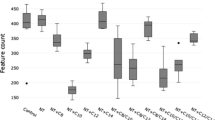Abstract
Seven known species of rumen ciliates and mixedEntodinium spp. showed association with plant particles in rumen fluid in vitro. Association was greater with fresh particles than with hay, and substantially decreased when the water-soluble components of the particles were removed, suggesting that the water-soluble components may be responsible for the association. The association was rapid and maximal between 5 and 35 min (depending on the ciliate species) after exposure to the particles, and involved major transfers of ciliate populations and biomass from the liquid phase to the solid phase of the system. The most rapid and largest population transfers to the particles from the rumen fluid were shown by the holotrich ciliates, where transfers of up to 97% of the population were recorded. Association with plant particles by all species examined occurred within the pH range 5.5–7.5, and decreased with time when the particles were incubated in rumen contents in vivo. The ciliate biomass transferring from the liquid to the solid phase varied with the composition of the ciliate population.
Similar content being viewed by others
References
Abe M, Kumeno F (1973)In vitro simulation of rumen fermentation: apparatus and effects of dilution rate and continuous dialysis on fermentation and protozoal population. J Anim Sci 36:941–948
Akin DE, Amos HE (1979) Mode of attack on Orchardgrass leaf blades by rumen protozoa. Appl Env Mic 37:332–338
Bailey RW, Clarke RTJ, Wright DE (1962) Carbohydrates of the rumen ciliateEpidinium ecaudatum (Crawley). Biochem J 83:517–523
Bauchop T (1979) The rumen ciliateEpidinium in primary degradation of plant tissues. Appl Env Mic 37:1217–1223
Bauchop T (1980) Scanning electron microscopy in the study of microbial digestion of plant fragments in the gut. In: Ellwood DC, Hedger JN, Latham MJ, Lynch JM, Slater JH (eds), Contemporary microbial ecology. Academic Press, New York, pp 305–326
Bauchop T, Clarke RTJ (1976) Attachment of the ciliateEpidinium Crawley to plant fragments in the sheep rumen. Appl Env Mic 32:417–422
Coleman GS (1978a) Rumen Entodiniomorphid protozoa. In: Taylor AER, Baker JR (eds), Methods of cultivating parasitesin vitro. Academic Press, London, pp 39–54
Coleman GS (1978b) The metabolism of cellulose, glucose and starch by the rumen ciliate protozoonEudiplodinium maggii. J Gen Mic 107:359366
Coleman GS (1979) Rumen ciliate protozoa. In: Levandowsky M, Hutner SH (eds), Biochemistry and physiology of protozoa. Academic Press, New York, pp 381–408
Coleman GS, Dawson RMC, Grime DW (1980) The rate of passage of ciliate protozoa from the ovine rumen. Proc Nut Soc 39:6A
Coleman GS, Laurie JI, Bailey JE, Holdgate SA (1976) The cultivation of cellulolytic protozoa isolated from the rumen. J Gen Mic 95:144–150
Eadie JM (1962) Inter-relationships between certain rumen protozoa. J Gen Mic 29:579–588
Gutierrez J (1955) Experiments on the culture and physiology of holotrichs from the bovine rumen. Biochem J 60:516–522
Harrison DG, Beever DE, Osborn DF (1979) The contribution of protozoa to the protein entering the duodenum of sheep. Br J Nut 41:521–527
Holler H, Harmeyer J (1965) Der Stickstoff und Aminosaurengehalt von Panserprotozoen. Zentralbl. Veterinaermed., Reihe A 11:244–251
Hungate RE (1966) The rumen and its microbes. Academic Press, New York
McDougall EI (1948) Studies on ruminant saliva. 1. Composition and output of sheep's saliva. Biochem J 43:99–109
Orpin CG (1976) Studies on the defaunation of the ovine rumen using dioctyl sodium sulphosuccinate. J Appl Bact 43:309–318
Orpin CG (1979) Association of rumen ciliate protozoa with plant particlesin vitro. Soc Gen Mic Quarterly 7:31–32
Orpin CG, Hall FJ (1977) Attachment of the rumen holotrich protozoonIsotricha intestinalis to grass particles. Proc Soc Gen Mic 4:82–83
Orpin CG, Letcher AJ (1978) Some factors controlling the attachment of the rumen holotrich protozoaIsotricha intestinalis andI. prostoma to plant particlesin vitro. J Gen Mic 106:33–40
Warner ACI (1962) Enumeration of rumen microorganisms. J Gen Mic 28:129–146
Weller RA, Pilgrim AF (1974) Passage of protozoa and volatile fatty acids from the rumen of the sheep and from a continuousin vitro fermentation system. Br J Nut 32:341–351
Author information
Authors and Affiliations
Rights and permissions
About this article
Cite this article
Orpin, C.G. Association of rumen ciliate populations with plant particles in vitro. Microb Ecol 11, 59–69 (1985). https://doi.org/10.1007/BF02015109
Issue Date:
DOI: https://doi.org/10.1007/BF02015109




